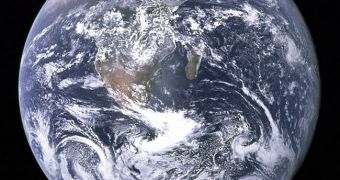As we reported earlier today, a team of investigators from the Southwest Research Institute determined in a study that elements such as gold and platinum were brought here by space impactors. In the same study, the researchers also showed that those impacts marked the final stages of planetary growth.
The NASA-funded researchers now propose a new theory about how planets completed their growth process. They argue that the final collisions, which brought the chemicals into the mantles and cores of the Mars, Moon and Earth, also added the last important amounts of mass to the bodies.
This mass gain was brought on by a limited number of comet or asteroid impacts, which experts say took place more than 4.5 billion years ago. At the time, Earth was only tens of millions of years old.
In the case of Earth, the new measurements indicate that about 1 percent of the planet's total mass did not originate here, but was brought on by comets and asteroids from the solar system.
The reason why the new theory is so important it that it may help planetary scientists get a better insight into the middle stages of planetary formation, which are now shrouded in secrecy.
Additionally, the the birth and evolution of Earth, the Moon and Mars may also get some much needed clarifications, as will the earliest days of the solar system, when the plants started forming.
“No one has a model of precisely what happened at the end of planet formation – we’ve had a broad idea – but variables such as impactor size, the approximate timing of the impacts, and how they affect the evolution of the planets are unknown,” explains William Bottke
“This research hopefully provides better insights into the early stages of planet formation,” adds the SwRI expert, who was also the principal investigator on the new study.
“These impactors probably represent the largest objects to hit Earth since the giant impact that formed our Moon,” he adds. The largest impactor to slam our planet at that time was probably between 1,500 - 2,000 miles in diameter.
“They also may be responsible for the accessible abundance of gold, platinum, palladium, and other important metals used by our society today in items ranging from jewelry to our cars’ catalytic converters,” the team leader adds.
Bottke and SwRI colleague David Nesvorny, together with experts from several major universities and research centers in the US, published the finding in a paper called “Stochastic Late Accretion to the Earth, Moon, and Mars.”
The work appears in the December 9 issue of the top scientific journal Science. The NASA Lunar Science Institute (NLSI), which is located at the agency's Ames Research Center in Moffett Field, California, sponsored the investigation.

 14 DAY TRIAL //
14 DAY TRIAL //